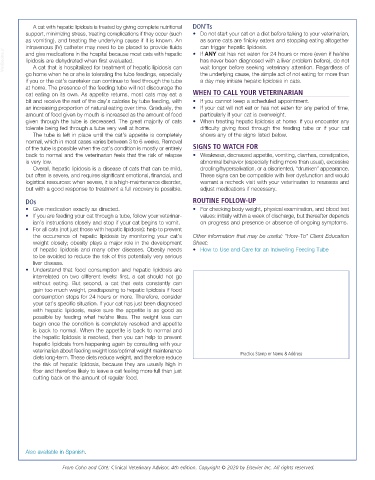Page 3026 - Cote clinical veterinary advisor dogs and cats 4th
P. 3026
A cat with hepatic lipidosis is treated by giving complete nutritional DON’Ts
support, minimizing stress, treating complications if they occur (such • Do not start your cat on a diet before talking to your veterinarian,
as vomiting), and treating the underlying cause if it is known. An as some cats are finicky eaters and stopping eating altogether
can trigger hepatic lipidosis.
intravenous (IV) catheter may need to be placed to provide fluids • If ANY cat has not eaten for 24 hours or more (even if he/she
VetBooks.ir lipidosis are dehydrated when first evaluated. has never been diagnosed with a liver problem before), do not
and give medications in the hospital because most cats with hepatic
A cat that is hospitalized for treatment of hepatic lipidosis can
wait longer before seeking veterinary attention. Regardless of
go home when he or she is tolerating the tube feedings, especially the underlying cause, the simple act of not eating for more than
if you or the cat’s caretaker can continue to feed through the tube a day may initiate hepatic lipidosis in cats.
at home. The presence of the feeding tube will not discourage the
cat eating on its own. As appetite returns, most cats may eat a WHEN TO CALL YOUR VETERINARIAN
bit and receive the rest of the day’s calories by tube feeding, with • If you cannot keep a scheduled appointment.
an increasing proportion of natural eating over time. Gradually, the • If your cat will not eat or has not eaten for any period of time,
amount of food given by mouth is increased as the amount of food particularly if your cat is overweight.
given through the tube is decreased. The great majority of cats • When treating hepatic lipidosis at home: if you encounter any
tolerate being fed through a tube very well at home. difficulty giving food through the feeding tube or if your cat
The tube is left in place until the cat’s appetite is completely shows any of the signs listed below.
normal, which in most cases varies between 3 to 6 weeks. Removal
of the tube is possible when the cat’s condition is mostly or entirely SIGNS TO WATCH FOR
back to normal and the veterinarian feels that the risk of relapse • Weakness, decreased appetite, vomiting, diarrhea, constipation,
is very low. abnormal behavior (especially hiding more than usual), excessive
Overall, hepatic lipidosis is a disease of cats that can be mild, drooling/hypersalivation, or a disoriented, “drunken” appearance.
but often is severe, and requires significant emotional, financial, and These signs can be compatible with liver dysfunction and would
logistical resources: when severe, it is a high-maintenance disorder, warrant a recheck visit with your veterinarian to reassess and
but with a good response to treatment a full recovery is possible. adjust medications if necessary.
DOs ROUTINE FOLLOW-UP
• Give medication exactly as directed. • For checking body weight, physical examination, and blood test
• If you are feeding your cat through a tube, follow your veterinar- values: initially within a week of discharge, but thereafter depends
ian’s instructions closely and stop if your cat begins to vomit. on progress and presence or absence of ongoing symptoms.
• For all cats (not just those with hepatic lipidosis): help to prevent
the occurrence of hepatic lipidosis by monitoring your cat’s Other information that may be useful: “How-To” Client Education
weight closely; obesity plays a major role in the development Sheet:
of hepatic lipidosis and many other diseases. Obesity needs • How to Use and Care for an Indwelling Feeding Tube
to be avoided to reduce the risk of this potentially very serious
liver disease.
• Understand that food consumption and hepatic lipidosis are
interrelated on two different levels: first, a cat should not go
without eating. But second, a cat that eats constantly can
gain too much weight, predisposing to hepatic lipidosis if food
consumption stops for 24 hours or more. Therefore, consider
your cat’s specific situation. If your cat has just been diagnosed
with hepatic lipidosis, make sure the appetite is as good as
possible by feeding what he/she likes. The weight loss can
begin once the condition is completely resolved and appetite
is back to normal. When the appetite is back to normal and
the hepatic lipidosis is resolved, then you can help to prevent
hepatic lipidosis from happening again by consulting with your
veterinarian about feeding weight loss/optimal weight maintenance
diets long-term. These diets reduce weight, and therefore reduce Practice Stamp or Name & Address
the risk of hepatic lipidosis, because they are usually high in
fiber and therefore likely to leave a cat feeling more full than just
cutting back on the amount of regular food.
Also available in Spanish.
From Cohn and Côté: Clinical Veterinary Advisor, 4th edition. Copyright © 2020 by Elsevier Inc. All rights reserved.

